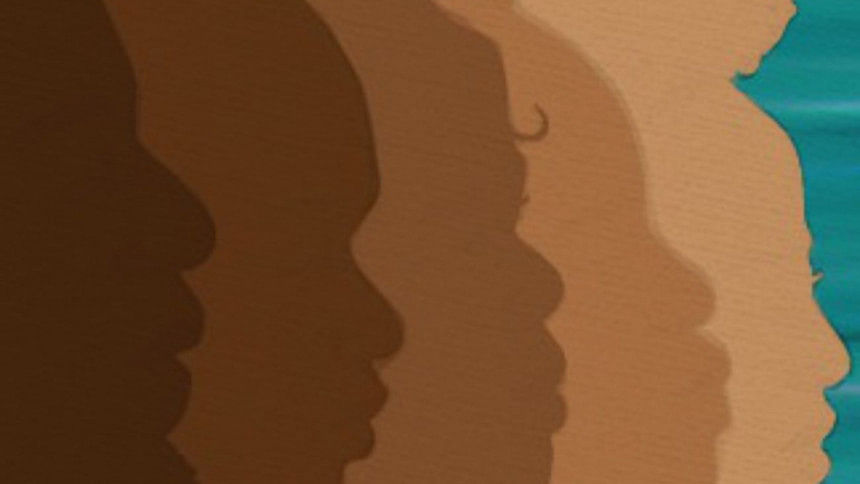Can we make the world colour-blind?

Lately I have started feeling conscious about the colour of my skin again. It is a jolting realisation that so much depends on it—the level of attractiveness or unattractiveness I possess, the amount of deference I may receive from people in lesser social positions, what kind of job I will get, who will love me and how much of my existence will be tolerated by others. It is mindboggling that even after centuries of activism, struggles and debunking of the white superiority myths, we are stuck in this medieval stage of judging a human being's worth by the colour of their skin.
Yet there it is—an inescapable, undesirable truth. And it goes far beyond the silly jibes of how you didn't get your mother's buttery complexion or the delicate hints by the parlour assistant that a "fair polish" is in order to "brighten" your dark, dull skin.
Yes, in a South Asian context, or rather an Asian context, skin colour determines how well a female will marry and how large or small the dowry her family will have to pay to her groom's family. Hence the obsession with skin lightening at any cost. This is old news and sadly has been able to brazenly flourish even in this day and age.
But let us think about the deeper consequences of shadism all over the world. Think about why 480,000 (and counting) brown-skinned refugees have flooded our shores to escape indescribable brutality of their fellow countrymen. The Rohingya are hated in their homeland because they look a certain way—Bengali: "One of the few things Rakhines and members of the ethnic Burmese majority have in common is a shared hatred of the 'Bengalis', a label they both apply to Rohingya with contempt." (Economist, May 2015). Kyaw Zwa Moe, managing editor of The Irrawaddy magazine, in a recent commentary mentions how a Burmese counsel in Hong Kong in a letter (in 2009) to fellow diplomats referring to Rohingya boatpeople remarked: "You will see in the photos that their complexion is dark brown," contrasting the complexion of Burmese as "fair and soft, good looking as well," and adding, "Rohingyas are as ugly as ogres".
Predominantly Muslim, their religion makes for the most hated combination—Muslims who are dark-skinned. It is not unlike the racism that drove the Pakistani army to brutally kill, maim and rape Bengalis in the then East Pakistan—they were "dark and scrawny", they were Hindu or "not pure Muslims", generally not eligible to be equal citizens. Thus racism can extend from the community level to become an institutionalised, political strategy to humiliate, intimidate and eventually annihilate. Why else would an entire ethnic group be stripped of their citizenship and then treated for decades like unwanted outsiders?
The selective acceptance of refugees is ample indication of just how far skin colour, which is often a defining characteristic of ethnicity or race, can go. It is why refugees who are lighter skinned are more acceptable than those who are darker. It is why a light-skinned Muslim refugee of Arab descent is preferable to a brown-skinned or black skinned South Asian or African Muslim.
According to a study titled The Shadow Report on Afrophobia in Europe by European Network Against Racism, there is blatant discrimination against people of African descent and Black Europeans in all areas of life. This includes the way they are treated in school, by the police and criminal justice system as well as in the job market. Refugees, asylum seekers and regular immigrants, particularly, are treated with contempt and resentment, more so if their skin colour is dark.
According to this report, black people face obstacles at every stage of employment in Europe: "In the United Kingdom, applicants with an African sounding surname need to send twice as many job applications as those with a White British sounding name to get an interview. Statistics across EU Member States show that people with an African origin have systematically higher unemployment rates than the national average, which is due in part to racial discrimination. In Finland, unemployment rates are more than three times higher for people of African origin (41.2%) compared to the national average (8.7%)."
In the US where racism is still very much part of the African American experience and which has spread to affect other communities—Asian, Middle Eastern and South Asian—ethnicity and religion have become influencing factors but the underlying bias regarding skin tones cannot be denied. In 2007, Joni Hersch, a law and economics professor at Vanderbilt University, looked at a government survey of 2,084 legal immigrants to the United States from around the world. One of her findings was that those with the lightest skin earned an average of eight to 15 percent more than similar immigrants with much darker skin. Light-skinned immigrants in the United States made more money on average than those with darker complexions. Her findings concluded that even for immigrants with the same ethnicity, country of origin, education, skills and English language proficiency, skin colour was a factor: the lighter-skinned individual would have a better paying job.
Another study by Mara Ostfeld, a political scientist and professor at University of Michigan, found distinct bias towards light-skinned immigrants when it came to the question of having them move into the neighbourhood or working alongside them or if someone in the family married an immigrant. Of course, in the present post-9/11 and post-Trump US, the Muslim factor may be the bigger deciding factor.
It is perhaps the greatest tragedy of this century that while technology has moved with exponential speed so that now we have information on just about anything at our fingertips, when it comes to expansion of our minds or rather our mindsets, we have regressed further than ever. We are caught in the world wide web of ultra-rightism, white supremacy, racism, bigotry and even apartheid—monsters, we naively thought, were debris of the past. Among all these monsters, prejudice based on skin tone is the most primal. It has existed from time immemorial and is entrenched in almost every corner of the globe. Disturbingly, it is the basest instinct in humans that no amount of education and knowledge-building has been able to erase.
So how do we get out of this contemptible crime of judging a human by his/her cover? Perhaps, it must start from the microcosm of family. If I can teach my children that skin colour is irrelevant in deciding who is beautiful or smart or worthy of respect, that being brown or black does not create some sort of cloak of inferiority, it is possible that this precious piece of information may reach the wider community and from the community to the nation and from the nation to the rest of the world.
At this point in time, human beings have become intolerant of just about everything and discrimination and aggression based on religion, caste, social status, race, ethnicity, nationality, political stand—you name it—are alive and multiplying. In such a minefield of breeding misery, can we not take a tiny step towards enlightenment? Can we not take out the colour of a person's skin from the equation?
Aasha Mehreen Amin is Deputy Editor, Editorial and Opinion, The Daily Star.





Comments